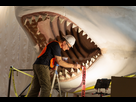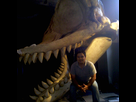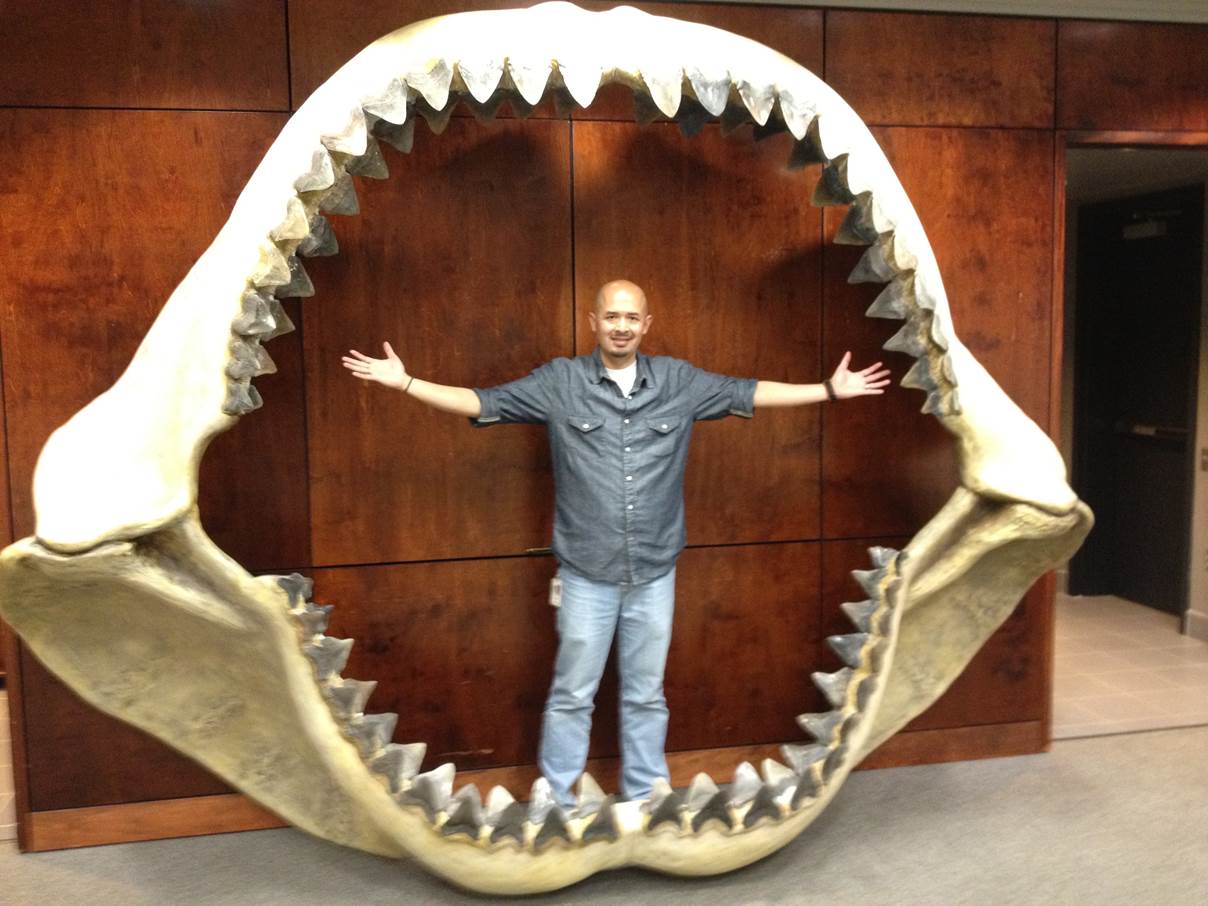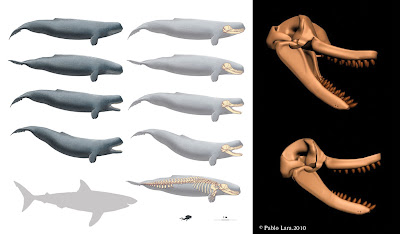|
|
Post by Grey on May 27, 2019 22:13:53 GMT 5
  A classic of me, left is the jaws je the 16 m new Carcharocles model, described as representing an average size female at the National Museum of Natural History of Washington. Right is the reconstructed skull of Livyatan at the equivalent Museum of Lima, each with a human for scale. These two dentitions probably represent the two most powerful raptorial apparatus known from any wildlife in the records. |
|
|
|
Post by elosha11 on May 28, 2019 7:49:56 GMT 5
^Two titans, that's for sure. Livytan with longer but more narrow jaws; and Megalodon with shorter, but wider jaws.
Has there been any significant and formal research on Livyatan other than the initial study on the holotype? I'm trying to remember if there's been any estimate on the degree of Livyatan's gape. It still seems to me that Megalodon's jaws are more adapted for really large bodied prey, both from a volume standpoint and from the cutting ability of its teeth. But of course Livyatan may have supplemented its bite with a ram style of attack to first incapacitate its prey before moving on to dismember it. Both animals could easily handle the medium size whales of their era.
|
|
|
|
Post by Grey on Aug 28, 2019 1:34:46 GMT 5
^Two titans, that's for sure. Livytan with longer but more narrow jaws; and Megalodon with shorter, but wider jaws. Has there been any significant and formal research on Livyatan other than the initial study on the holotype? I'm trying to remember if there's been any estimate on the degree of Livyatan's gape. It still seems to me that Megalodon's jaws are more adapted for really large bodied prey, both from a volume standpoint and from the cutting ability of its teeth. But of course Livyatan may have supplemented its bite with a ram style of attack to first incapacitate its prey before moving on to dismember it. Both animals could easily handle the medium size whales of their era. I had missed this. I don't know of any data about Livyatan gape. That is an interesting question that I should ask to the specialists in stem-physeteroids. Regardless, assuming the Aurora dentition represents a 17.1 m shark and using mouth width data of several large GWS individuals with known TL from the 1996 GWS book by Peter Klimley, I get several mouth width estimates for the Aurora specimen. Page 152-153 (adult females) : ~229 cm; 203 cm; 225 cm; 160 cm; 152 cm Page 154-155 (adult males) : 200 cm; 216 cm; 216 cm; 156 cm As you note, most of the scaling suggests a mouth width in the 2 m area but interestingly some others are around 150-160 cm. Maybe this has to do with how the mouth was measured ? Note I ve used only individuals above 4 m long. Any thoughts ? |
|
|
|
Post by elosha11 on Aug 31, 2019 23:13:16 GMT 5
Grey, I'd think it more likely a 17 meter Megalodon would have had a mouth width of 2+ meters rather than 1.5-1.6 meters. Certainly the more rigorous scientific jaw reconstructions would suggest a large Meg would have jaws substantially wider than two meters, such as the Houston Museum jaws. (Granted, this jaw set probably represents a larger specimen than 17.1 meters). On the other hand, the original 2010 paper's reconstructions of Livyatan's mouth width and gape suggests - while extraordinarily big on absolute terms - Livytan possessed substantially more narrow jaws than Meg, and could not necessarily open them as wide. Compare the gape and jaw width of the HM jaws to these depictions of Livy holotype in the original 2010 article:    |
|
|
|
Post by Grey on Sept 3, 2019 23:39:23 GMT 5
Elosha, do note that these jaws reconstructions are in an unatural pose, which enhances the size visually.
However I can say that Hans Sues, curator of the department of vertebrate paleontology and sharks specialists, sees Livyatan oral cavity to have been narrower than in the giant shark.
Of course we will sure of anything until we find a preserved meg jaw...
|
|
|
|
Post by Grey on Sept 3, 2019 23:42:50 GMT 5
 This model in a Chile (or Mexico ?) Museum may not be the most rigorous, especially the lower dentition but I suspect its overall size could well reflect the actual mouth size of the Houston or Bertucci models. |
|
|
|
Post by theropod on Sept 4, 2019 3:53:23 GMT 5
So, since we are assuming isometry between summed tooth (crown) widths and total length, certainly we can also assume isometry between jaw width and total length (and tooth widths). Due to different jaw shapes this might not necessarily be true eventually (should we ever find out), but it is a reasonable proxy for the overall jaw size; a proportionately wider or narrower mouth would accordingly decrease or increase the other dimensions since the size of the dentition, and hence the circumference, always remains the same. We can directly test what size of shark mounted jaw models really would correspond to, at least their width, or overall size given the shape is comparable to great white jaws, and whether or not they are realistic and/or representative. That last one may be a bit problematic, as it isn’t very close in shape to Carcharodon jaws and the back of its toothrow seems unnaturally constricted, but most modern reconstructions seem to do a somewhat decent job on the shape, even if some of the larger ones would seem a bit too broad (and overall excessively sized), so we should expect them to be a width an actual Carcharodon jaw would have when the animal was scaled to actual megalodon size estimates based on isometry and dentition width. For this one→ at reportedly 3.4m wide, I’m getting total length estimates between 27m and 37m based on the male white sharks in Uchida et al., so that width seems to be rather clearly oversized even if we allow for the mouth width to be somewhat smaller than the maximum width of the mounted jaws. Btw does someone have a pdf of this? Uchida, S., Toda, M., Teshima, K., Yano, K., Klimley, A.P. and Ainley, D.G. 1996. Pregnant white sharks and full-term embryos from Japan. In: Great White Sharks: The Biology of Carcharodon Carcharias, 139–156. Academic Press, San Diego, CA.The google preview is not showing me the beginning of the table with the TL measurements for the females. elosha11: The second Livyatan depiction→ was certainly not part of the original publication (or any other that I am aware of). I have no idea why it’s seen as authoritative by some people (I recall people thought so on carnivora as well), it’s an artistically nice model, but just one more plausible reconstruction among many. As I believe I have pointed here out before, the skull model suggests nothing at all about the gape angle (nor, for that matter, does the one from the description paper). Simply depicting a skull with the jaws open does not imply the angle is the maximum the animal could achieve. |
|
|
|
Post by Grey on Sept 4, 2019 4:19:54 GMT 5
I have been in contact with the owner of the Vito Bertucci model. He communicated by me through skype the combined width of the composite upper dentition and I compared the size of each tooth with the summed width.
It appears that the composite dentition assembled by Bertucci is reasonable and even somewhat conservative when comparing the decreasing size of the teeth.
So at least the upper dentition in this model is actually reasonable.
The only issue is how those jaws are mounted, which gives an erroneous view of the size.
The 3.4 m width is using the external fram and Merckel cartilage. But I confirm that the upper dentition is accurate in the choice of each teeth, despite what said Shimada.
Btw, I discuss with Shimada, he is now aware of the problems of his method.
Based on the Calvert Marine Museum 11.37 m model, the distance between the most posterior upper teeth in a 18 m model would be about 170 cm.
As for the Smithsonian 16 m model, the mouth width is 135 cm, interior opening measurements. Note the largest teeth in the model are 4.5 inches (not 6.2 inches as said in an article, confirmed by Hans Sues).
As for another comparison, the Aurora dentition is 3.5 times larger in summed width than what is observed in the C. hubbelli specimen...
C. hubbelli summed upper crown width : 313 mm
Aurora Otodus megalodon : 1 100 mm.
I think in Bertucci model, it was around 1350 mm.
The sheer width of the upper (140 mm) would have suggested even larger summed width (up to 1 500 mm).
Hence, Bertucci does not seem to have exaggerated the composite, only the pose of the jaws.
I think the larger estimates I posted above are due to the way how the mouth width were measured in my source, which is the source yoi are asking for theropod !
I suspect some of the mouth width measurements to be taken accounting the whole width of the head.
I have the whole book in PDF, I can send it by email.
Anyway, elosha, a 150 cm width between the last posterior teeth is already unknown from anything. Imagine a mouth a bit larger than the Smithsonian model that can already contain several people in sheer volume.
|
|
|
|
Post by Infinity Blade on Sept 4, 2019 4:25:32 GMT 5
Is it still okay for the topic title to have Carcharocles? The most recent study I've looked into r.e. megalodon's taxonomy recommends placing Carcharocles into Otodus to avoid paraphyly ( Shimada et al., 2016). However, I don't really keep track of developments into megalodon's taxonomy. |
|
|
|
Post by Grey on Sept 4, 2019 4:28:02 GMT 5
Otodus is the most recent assignement but I know Kent and Sues at least questions it. Actually it is simply arbitrary. I use Otodus because why not and it is shorter to write  |
|
|
|
Post by dinosauria101 on Sept 4, 2019 9:01:04 GMT 5
Should I change Carcharocles to Otodus in the title and OP?
|
|
|
|
Post by elosha11 on Sept 4, 2019 9:18:18 GMT 5
^Don't think you need to, but you could add Otudus as an alternative in the title. Either nomenclature seems relatively well accepted at the present time.
|
|
|
|
Post by jhg on Sept 4, 2019 10:28:24 GMT 5
I'm more used to Carcharocles but purely out of preference.
|
|
|
|
Post by theropod on Sept 4, 2019 15:02:17 GMT 5
While I usually appreciate any effort to make things monophyletic, I don’t agree that this makes any sense for genera. Every genus necessarily has an ancestor, whether it is known or not, so everything would necessarily have to be in the same genus if we stringently follow the logic that they are clades. If we restrict this to assigning known or suspected anagenetic lineages to the same genus, then the size of genera will only reflect the resolution of the sampling for a particular lineage. And this would cause newly discovered species to potentially affect the generic assignments of old ones, even if nothing about their phylogenetic relationships changes.
Genera are an inherently subjective concept, with the simple purpose of convenient nomenclature, and I would favour basing them on some measure of real morphological or genetic disparity.
Necessarily some will be paraphyletic, unless we want to make the concept of genera entirely useless.
For example, should we ever discover the suspected last common ancestor of all sharks, unlikely as that be, that would mean every shark descended from it, so if we assigned it to a genus that was not the same as every other shark, that genus would be paraphyletic.
If we discover another, earlier species that Otodus descended from, that would have to be Otodus as well. And so on, right back to the single-celled organism that all life descends from.
Phylogeny is needed for testing and improving generic assignments (e.g. if a species of "Megalosaurus" is an allosauroid, it’s safe to say it should be assigned to another genus), but that’s it, no point in trying to make genera into something objective when they are not.
In the case of Otodus/Carcharocles this is of course debatable. I think there is sufficient morphological disparity to warrant generic separation, so until there is an official consensus that we can all agree on for clarity, I’m sticking with C. megalodon.
|
|
|
|
Post by Grey on Sept 4, 2019 17:10:26 GMT 5
That is exactly what Kent and Sues argue about that. Thanks, no need to quote them.
To go back to the jaws subject, I suspect if the Bertucci jaws were accurately mounted they would approach 2 m in posterior teeth width. Which would look like the last model I put.
Of course it all depends the actual shape of the jaws, I remarked that living makos and GWS somewhat have an upper dentition in horse shoes. Which would mean the distance between the last posterior teeth would not be the widest. The CMM skeleton jaws model also shows that shape.
Anyway, in the 1996 book, chapter Predation and Scavenging on cetaceans, they report a bite width of from a 5.1 m GWS at 48 cm behind the last tooth. Which means 160 cm at 17 m.
Edit : looking at the pic with the mature lady standing in front of the jaws in "natural" position, the distance between the last teeth seems to be about 160 cm or so...
|
|